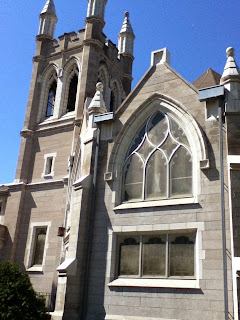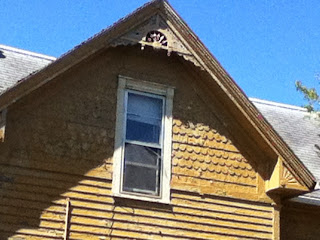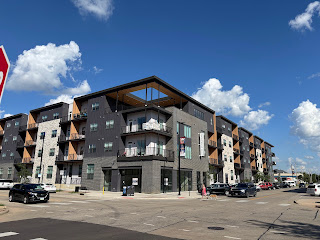 |
| Is this corner in need of a store? |
 |
| 1st Avenue Hy-Vee |
I spent seven hours a day, seven days a week, for seven dollars a week, in that little place crammed with drugs, lotions, tonics, tobacco, candy, ice cream, ointments, soft drinks, writing papers, newspapers, magazines, and the row of pumps with their many flavors called a soda fountain.... Now, of course, the drugstore culture has deteriorated--real drugs instead of a soda fountain! (Engle 1996: 36; similar reminiscences from Kingsport, Tennessee, in Stallard 2008)
 |
| The Paul Engle Center for Community Arts is in the former pharmacy building |
Today our city's groceries and pharmacies are mostly large, with some ethnic groceries in strip malls, and two recently-arrived gourmet groceries (Fresh Market and New Pioneer Co-op). Two Super Wal-Marts and two Super Targets also have grocery and pharmacy sections. None is particularly easy to walk to from any residential neighborhood, though the 1st Av and Oakland Road Hy-Vees aren't bad if you don't mind hustling around parking cars. And then there are the convenience stores, mostly attached to gasoline stations, the closest thing we have to the small, neighborhood stores of yore, but hardly the same breed of cat.
 |
| Jim's Foods, in a strip mall on 6th St SW, has survived by shifting to a convenience store model |
Because neighborhood stores have benefits, benefits that are widely touted, such that they appear on some level to be merit goods. Their presence reduces auto use and increases walking, increases the number of community-building interactions both in the store and on the way, and adds to the attraction of the area (Duany et al. 2000: 187-188; Jacobs 1961: 36-37; Mitchell 2009). Locally-owned stores, as opposed to mini-Targets or Wal-Marts, keep the profits in the community. From these direct benefits spring secondary benefits too numerous to list in a reasonable post. In particular, it's hard to imagine recent walkable-scale, residential development in downtown Cedar Rapids and the nearby areas of Kingston and New Bohemia succeeding for long without stores where life's necessities can be purchased.
Benefits or not, any reappearance of neighborhood stores faces serious hurdles. As urban areas sprawled in the latter half of the 20th century, people moved far away from shopping and work. Hunter and Henry note that the Fifth Avenue Market and Grocery once had over 100 houses nearby, almost all of which have been torn down (p. 55). Residences may now be too widely dispersed to support a small neighborhood store. Functional zoning means commercial and residential uses are kept apart: neighborhood over here, stores over there. Even where zoning ordinances permit mixed-uses, residents are often hostile to the idea of inviting corner stores into their neighborhoods. Duany, Plater-Zyberk and Speck explain:
[W]hat the neighbors are picturing instead is a Quick Mart: an aluminum and glass flat-topped building bathed in fluorescent light, surrounded by asphalt, and topped by a glowing plastic sign. It's not that these people don't need convenient access to orange juice and cat food like everyone else; they just know that the presence of a Quick Mart nearby will make their environment uglier and their property values lower.... The building type of this corner store is essentially the same as the town houses next to it: two stories high, three windows wide, built of brick, and situated directly against the sidewalk, which its entrance faces. One could imagine it may even have been a town house once, so well does it blend in among its neighbors. [2000: 26-27]Finally, there is the business plan question: Can neighborhood stores make a profit when most people can drive to a supermarket with wider selection and (I'm guessing) lower prices? I did some furtive price comparison today on a "market basket" of breakfast items, with these results:
Supermarket (large store)
|
Supermarket (small semi-walkable store)
|
Posh market
|
C-store
|
|
½ gal skim milk
|
1.58
|
1.69
|
1.99
|
3.39
|
Orange juice (12 oz conc or 48 oz bottle)
|
1.98
|
1.79
|
5.70
|
8.00
|
Sandwich bread (24 oz)
|
1.69
|
1.69
|
5.25
|
n.a.
|
Name brand wheat flakes cereal (10.9 oz)
|
2.50
|
2.50
|
5.50
|
n.a.
|
One dozen large eggs
|
2.09
|
2.68
|
2.99
|
n.a.
|
Oranges (1 lb)
|
1.59
|
1.99
|
1.50
|
n.a.
|
TOTAL
|
11.43
|
12.34
|
22.93
|
n.a.
|
Maybe I picked the wrong c-store? Anyway, it shows that the farther you get from the suburban supermarket model the more prices go up, and for anyone with a car that can be a deciding factor. So does the same logic apply to a corner store?
Duany and colleagues suggest that developers not only include corner stores, but provide the space rent-free because the store makes an attractive amenity yet "should not be expected to turn a profit until the neighborhood matures" (2000: 187). But that applies to new development, and doesn't analogize well to existing neighborhoods.
 |
| Highway 100 extension, from thegazette.com; can we sprawl our way to neighborhood stores? |
SOURCES
Andres Duany, Elizabeth Plater-Zyberk and Jeff Speck, Suburban Nation: The Rise of Sprawl and the Decline of the American Dream (North Point, 10th anniversary ed, 2010)
Paul Engle, A Lucky American Childhood (University of Iowa Press, 1996)
George T. Henry and Mark W. Hunter, Cedar Rapids: Downtown and Beyond (Arcadia, 2005)
Jane Jacobs, The Death and Life of Great American Cities (Random House, 1961)
Stacy Mitchell, "Neighborhood Stores: An Overlooked Strategy for Fighting Global Warming," Institute for Local Self-Reliance, 19 August 2009, http://www.ilsr.org/neighborhood-stores-overlooked-strategy-fighting-global-warming/
"Neighborhood Store," BusinessDictionary.com, http://www.businessdictionary.com/definition/neighborhood-store.html ... their definition, oriented to specialty stores, is too restrictive for our purposes
Kenny Stallard, "Neighborhood Stores," Memories from the Past, 2008[?], http://freepages.military.rootsweb.ancestry.com/~whitetwp/neighborhood_stores.htm
EARLIER POSTS
Envisioning CR I: A 24-hour downtown, 1 March 2015
Envisioning CR II: Including the poor, 17 March 2015
Envisioning CR III: Improve public transportation, 6 April 2015
NEXT: Regional governance.



























